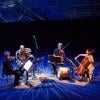
The Kronos Quartet gave its first performance in November 1973, and now the group is performing a year of concerts celebrating its 50th anniversary. The Quartet’s thoroughly engrossing March 2 program at Cal Performances took a glance back but also included three pieces from 2022 and 2023 — one of them, characteristically, a world premiere. All works on the program were among the staggering 1,100 composed or arranged for Kronos. And also characteristically, the sound design was by longtime Kronos associate Scott Fraser.
In honor of the anniversary, the documentary filmmaker Sam Green produced a brief film, KRONOS at FIFTY, and it was screened at the beginning of the program. Members of Kronos speak directly to the camera, wryly and with love. One alludes to the difficulties of life in a string quartet. You get glimpses of reviews, publicity material, CDs, concerts, an enormous archive, photos of the group at all stages, changing personnel and all.
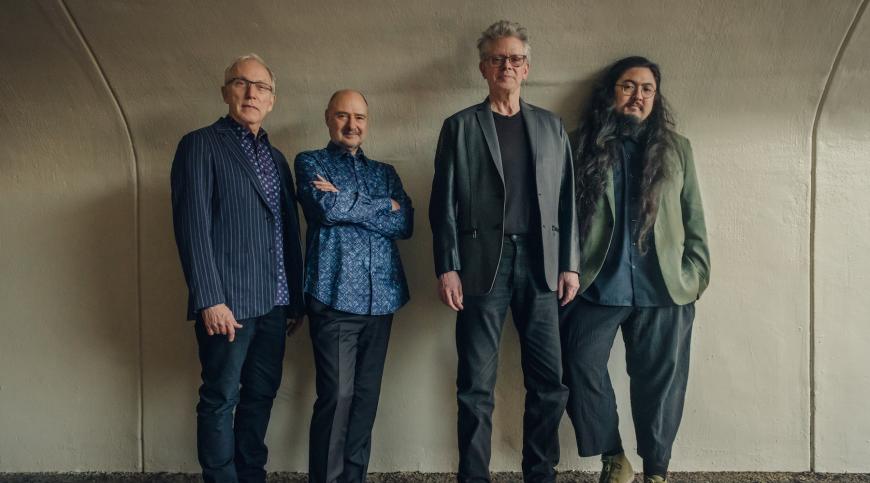
Paul Wiancko, who joined just last year, is Kronos’s sixth cellist. First violinist David Harrington is the only founding member still playing. Violist Hank Dutt and second violinist John Sherba have been members since 1977 and 1978, respectively. And just today, the Quartet announced that Dutt and Sherba will retire at the end of June 2024, concluding 46 years with the ensemble. Gabriela Díaz and Ayane Kozasa will join Kronos as second violin and viola.
Steve Reich’s Triple Quartet, from 1999, made the slightest impression of everything on Saturday’s program. It’s certainly vintage Reich in its three movements (slow, fast, slow) that run together and chug along with his typical rhythmic modulations. The Triple Quartet can be performed by three live quartets, by a single quartet with the other two recorded, or with two quartets with one recorded. The performers definitely get to choose their own adventure.
The earliest piece on the program, Sofia Gubaidulina’s Quartet No. 4 (1993), is a work of fragile intensity and resilience. A recording opens the quartet, providing a ghostly background of hollow sounds that you can’t quite identify. Are these percussion instruments? The live performers enter and eventually overcome the recording with impassioned dissonances and skittering panic. As the work progresses, the players produce the percussion in question, balls attached to wires that are bounced off the strings of their instruments, and the quartet closes much as it opened.
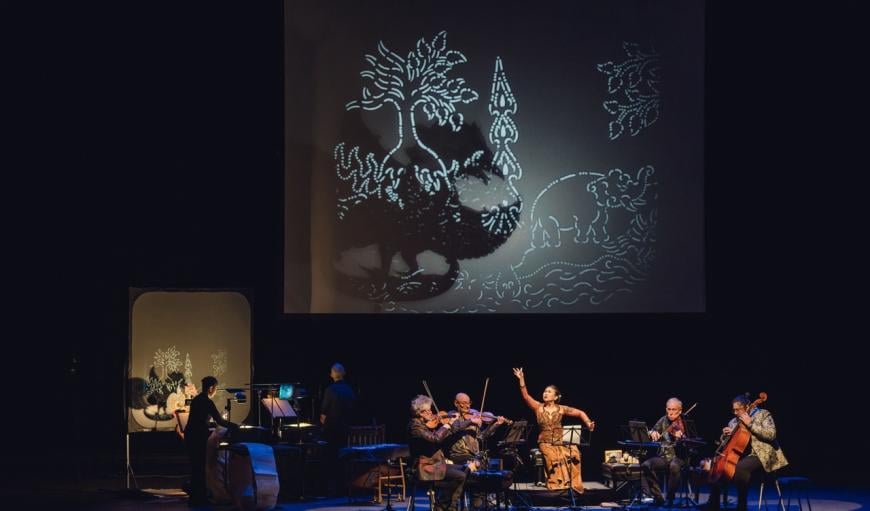
Harrington introduced composer, poet, and songwriter Peni Candra Rini as one of the world’s greatest singers. After hearing her performance in her own Segara Gunung, the program’s world premiere, I wouldn’t argue with him. Candra Rini has a warm voice with astonishing control of dynamics, ornamentation, vibrato, and tonal quality. She can sing sweetly or darkly, snarl or float.
Segara Gunung means “ocean mountain,” and the work is about Indonesians and their relationship with the natural world, as well as impending ecological disaster. It’s a theatrical piece, and shadow puppets are integral to it. You see trees, elephants, bulls butting heads, and cattle copulating, all projected on a screen behind Kronos and the composer. Candra Rini gestured throughout, her hands dancing with intricately expressive choreography.
I don’t have the knowledge to describe Segara Gunung in terms of classical gamelan; we heard it in an arrangement for string quartet by Jacob Garchik and Andy McGraw. The four movements took every advantage of the techniques available to string players. The cello was particularly prominent, accompanying Candra Rini in the second movement, acting as a percussion instrument in the fourth. One of the shadow-theater performers also played some instruments, and the work closed with the most beautiful chimes imaginable.
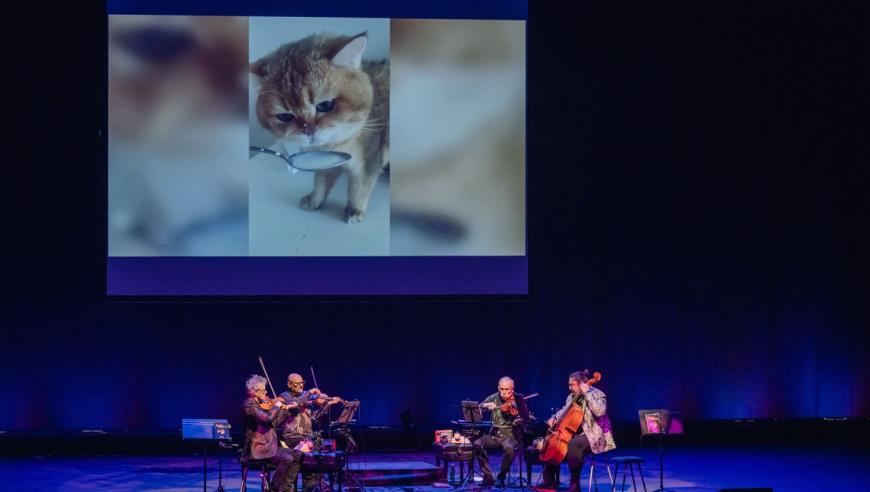
Kronos played several movements of Michael Gordon’s gfedcba, a modular set of musical vignettes, some of which include video. They’re modeled on Haydn’s scherzos, and the selections that Kronos played certainly had all the wit of their 18th-century predecessor. The last featured an extremely funny video of a cat being served milk in a spoon.
That video was perhaps a setup for the last piece on the program, Nicole Lizée’s brilliantly surreal ZonelyHearts. The composer’s titles for three of the five movements are suggestive: “Opening Credits,” “PhoneTap + CCTV,” and “Static Interference.” Rod Serling’s TV show The Twilight Zone provided spiritual and visual inspiration. Opposition to government surveillance, book bans, censorship, and other forms of social control are also at the heart of ZonelyHearts.
The spectacular result combined video of a series of bizarre events with music. ZonelyHearts felt something like a visit to Culver City’s Museum of Jurassic Technology, a work of performance art masquerading as a museum. (If you know, you know; if not, you should go.)
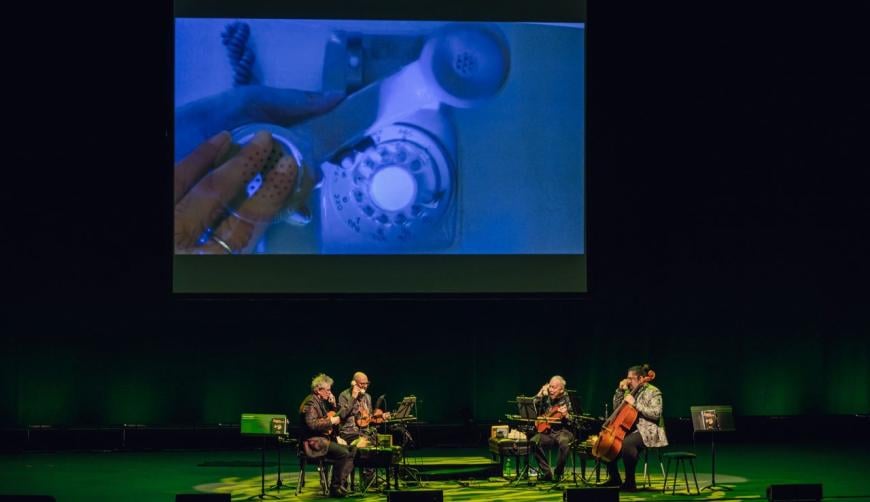
In the ZonelyHearts video, you see, among other things, tiny model TVs that sometimes contain unidentified Jell-O-like substances, fake eyeballs, aliens, cutouts of Kronos members, written phrases such as “Enter at your own risk,” rotary telephones, members of the Quartet behaving unusually. Onstage, the musicians sometimes sang and chanted into their own rotary phones.
At one point, they said that their bows had been stolen, so they played their instruments with paper tubes attached to eyeballs. Was this live or in the video? My notes don’t say, but it also hardly matters. There was music, and it always worked brilliantly with the combination of live and recorded action. In fact, at various points in the video, you saw excerpts from the music onscreen as it was being played. And sometimes the players shouted: for example, “Lies! Lies! Nothing but [lies]!”
Kronos opened with Osvaldo Golijov’s arrangement of El Sinaloense (The man from Sinaloa), a song by the Mexican composer Severiano Briseño that got a fast, fun, folksy, and slightly scruffy performance, appropriate for the subject, a bawdy drinker. For an encore, the Quartet played a signature work, Steve Rifkin’s arrangement of Jimi Hendrix’s Purple Haze.



